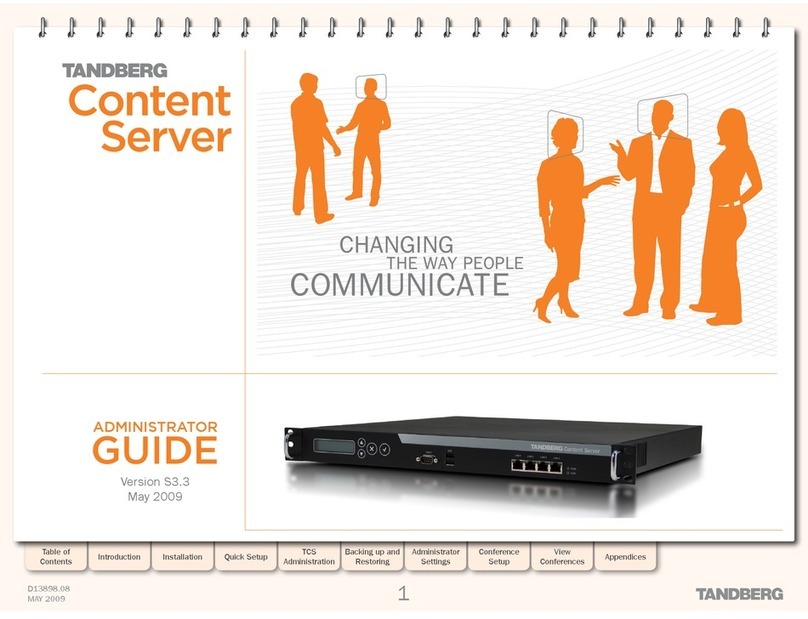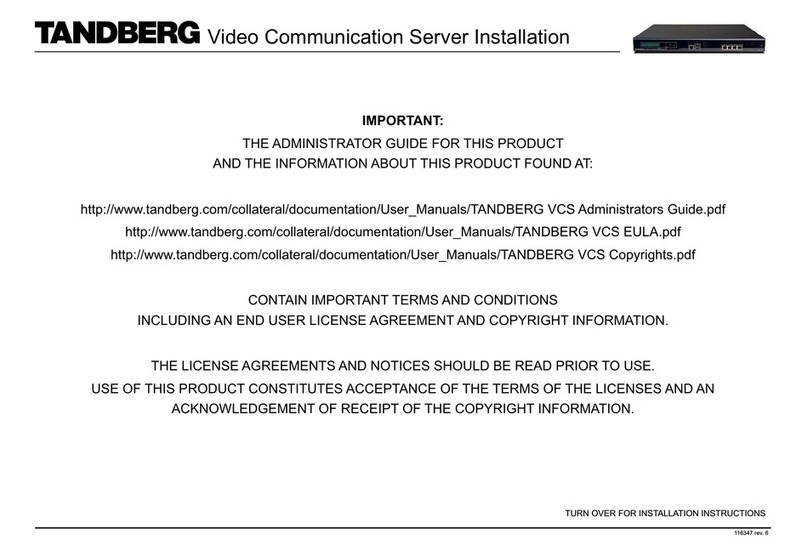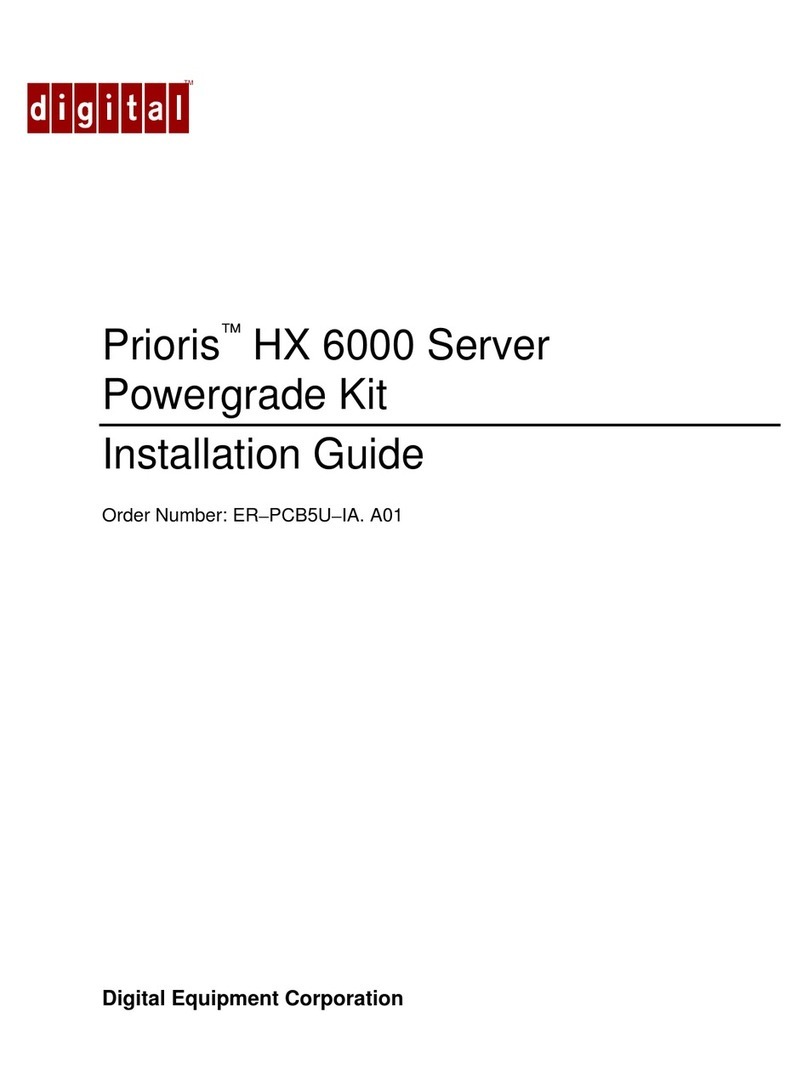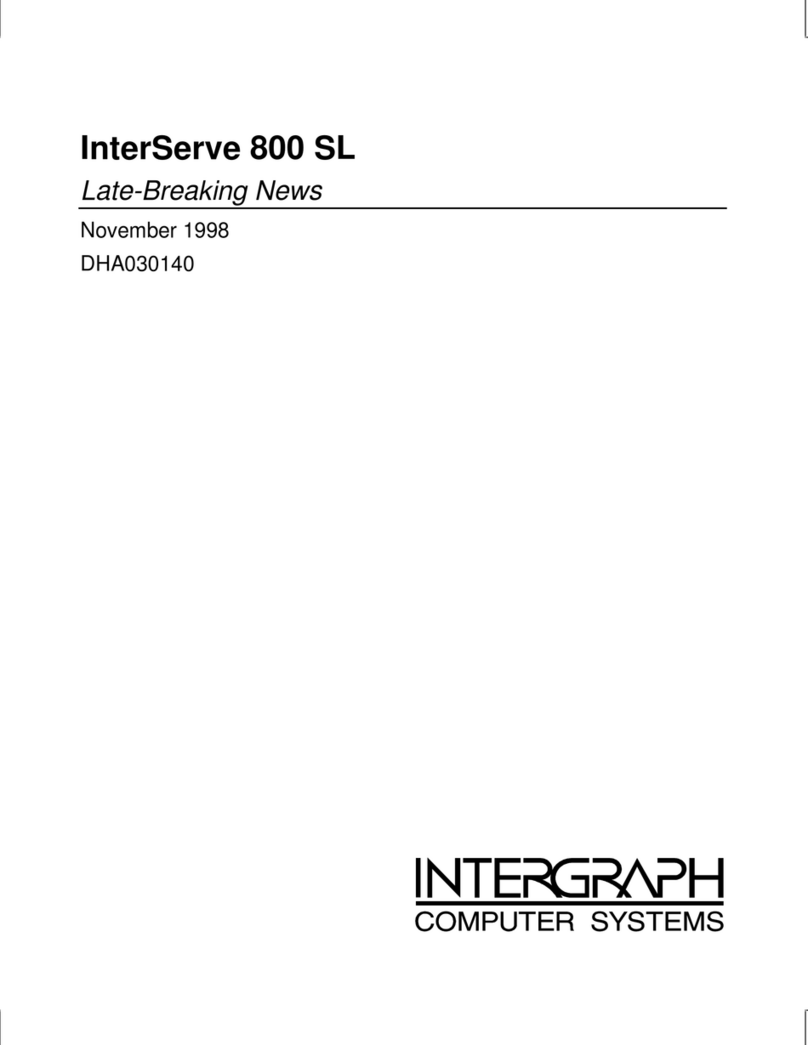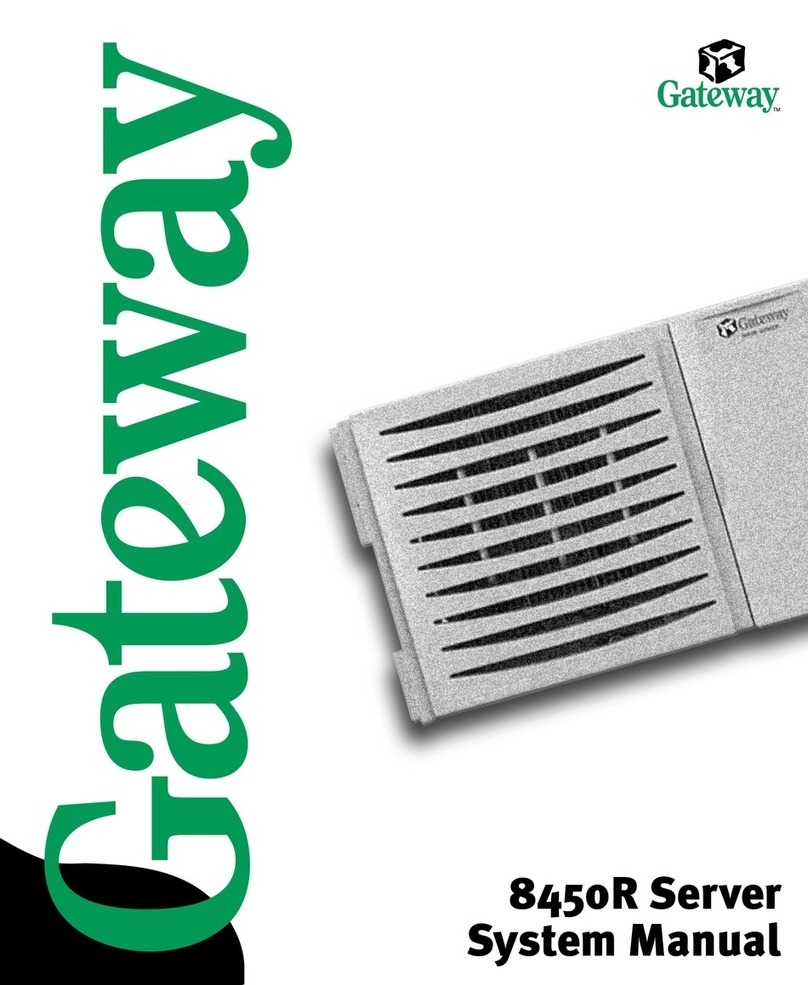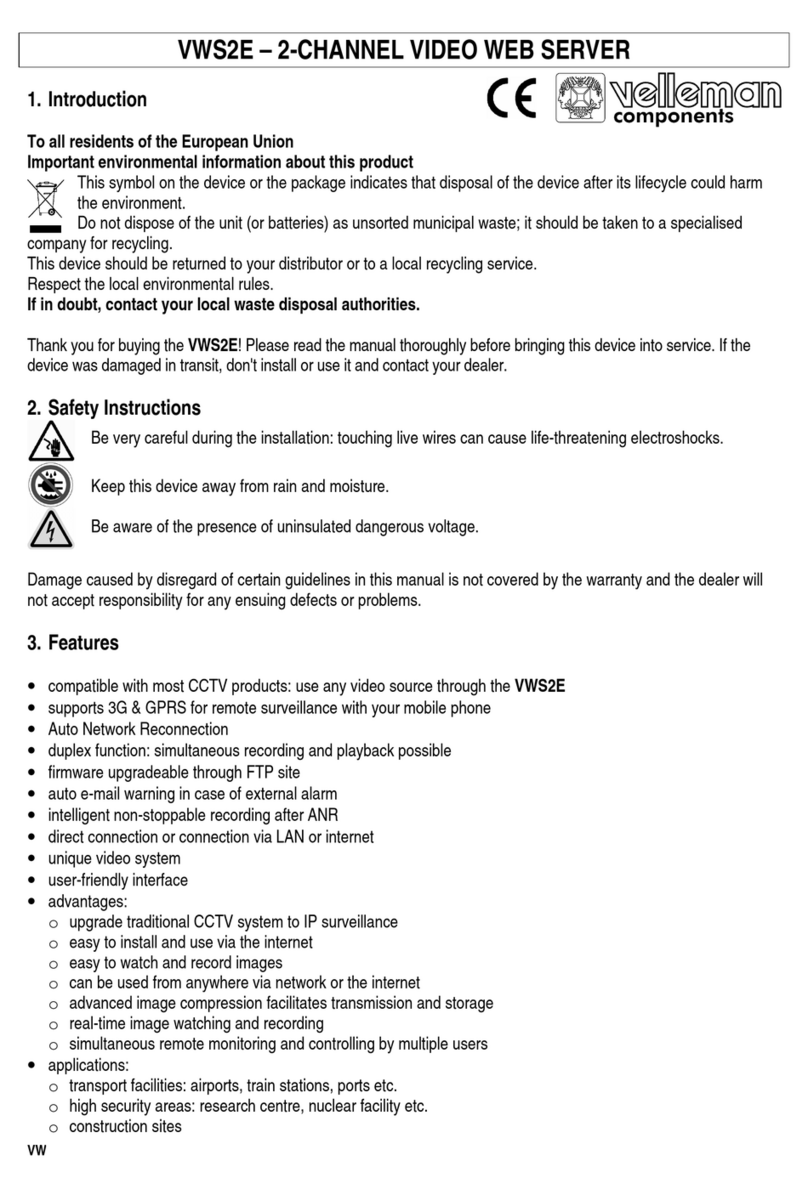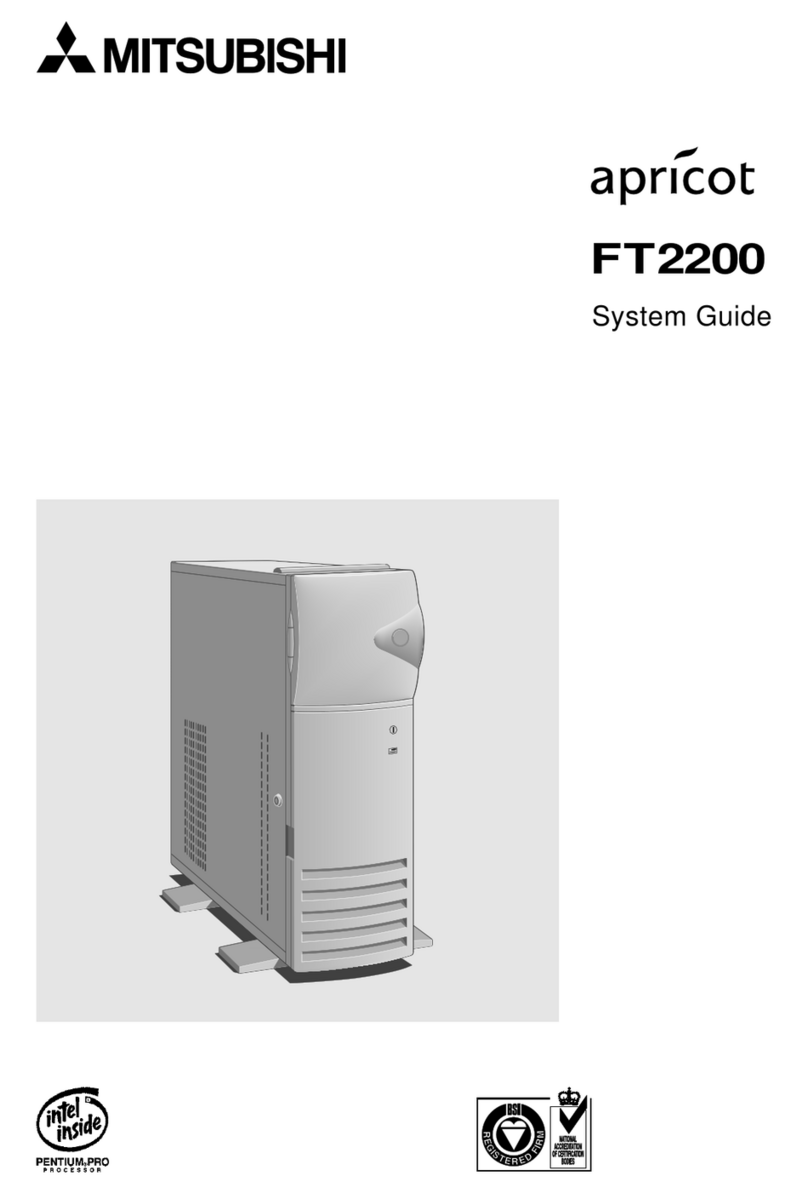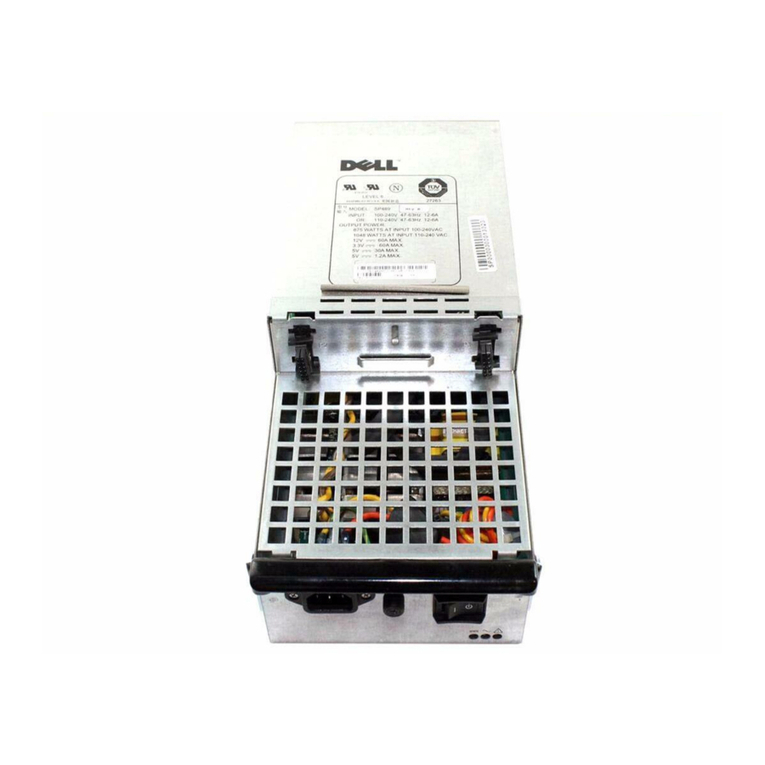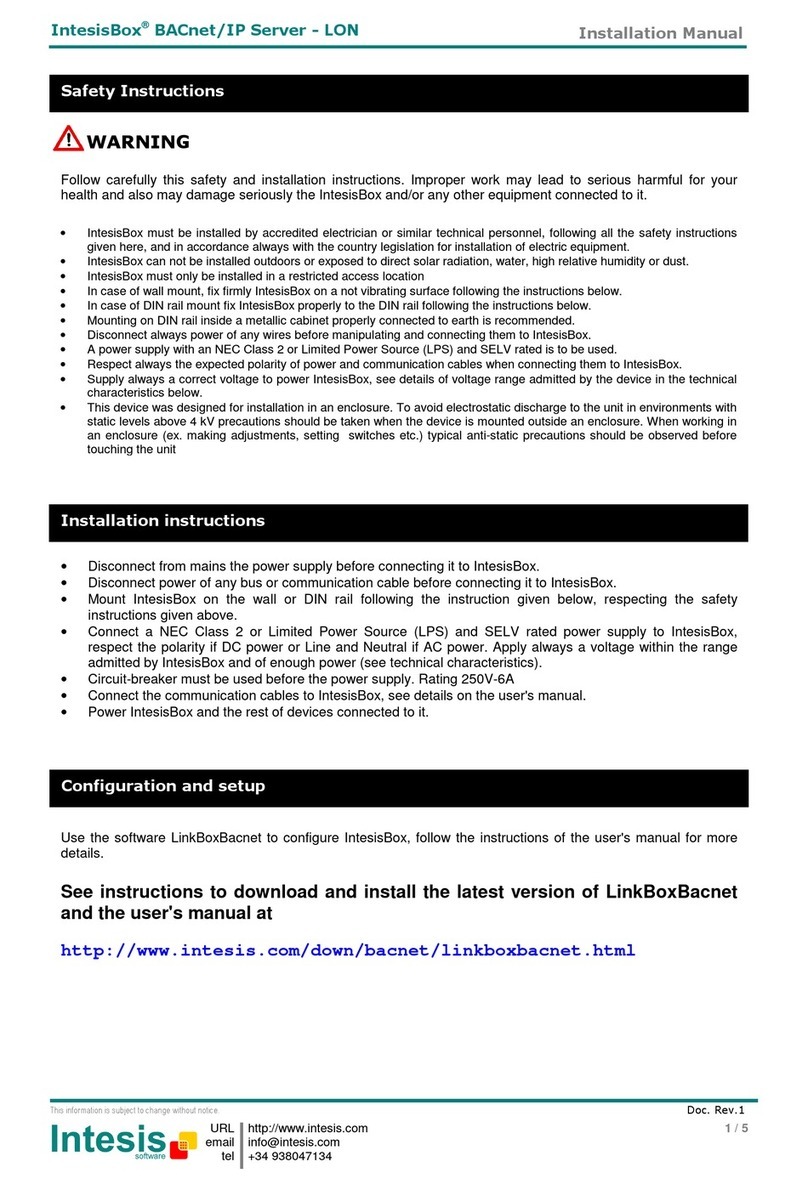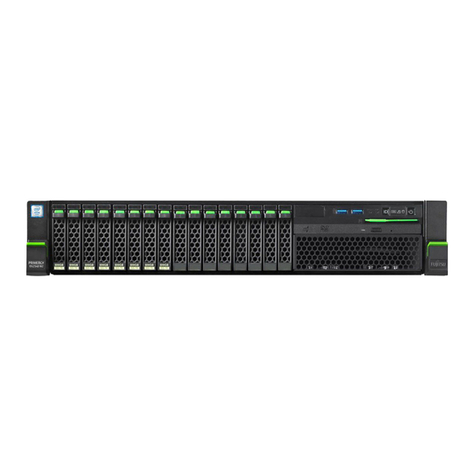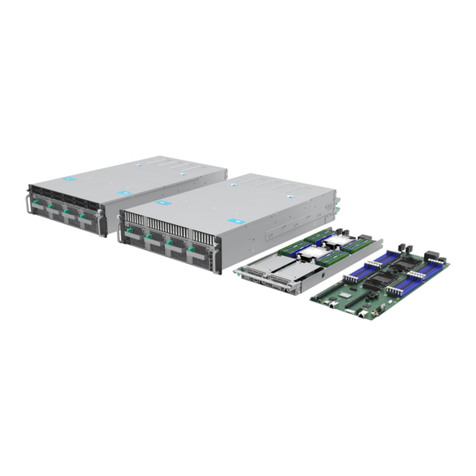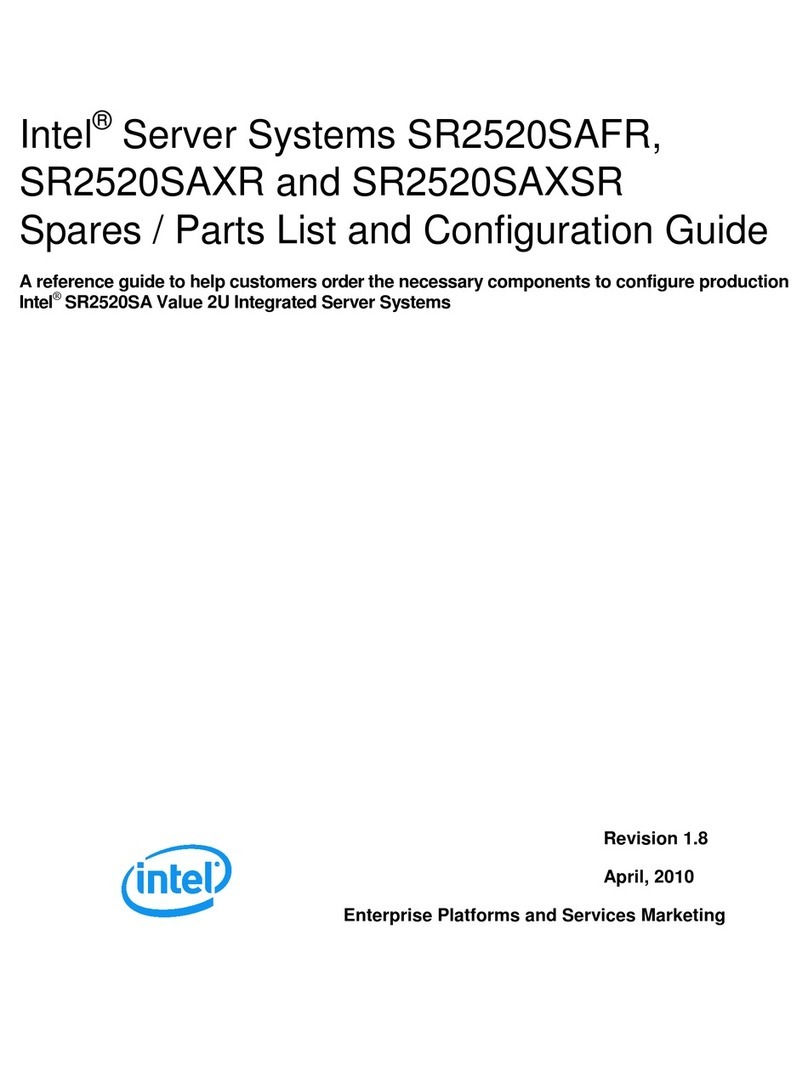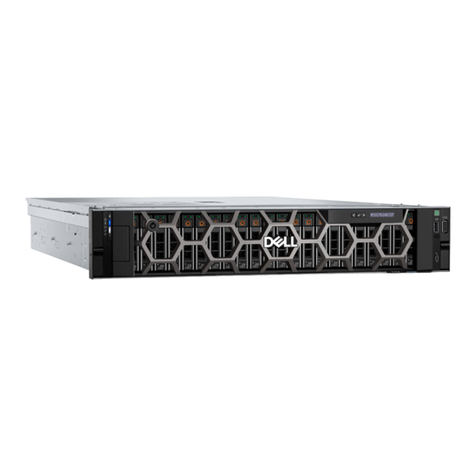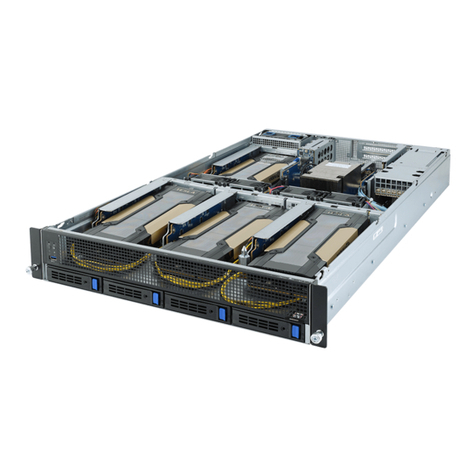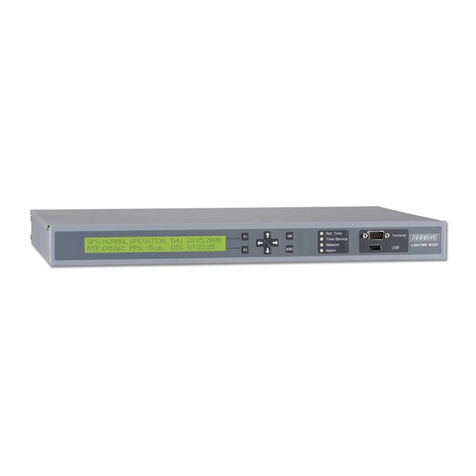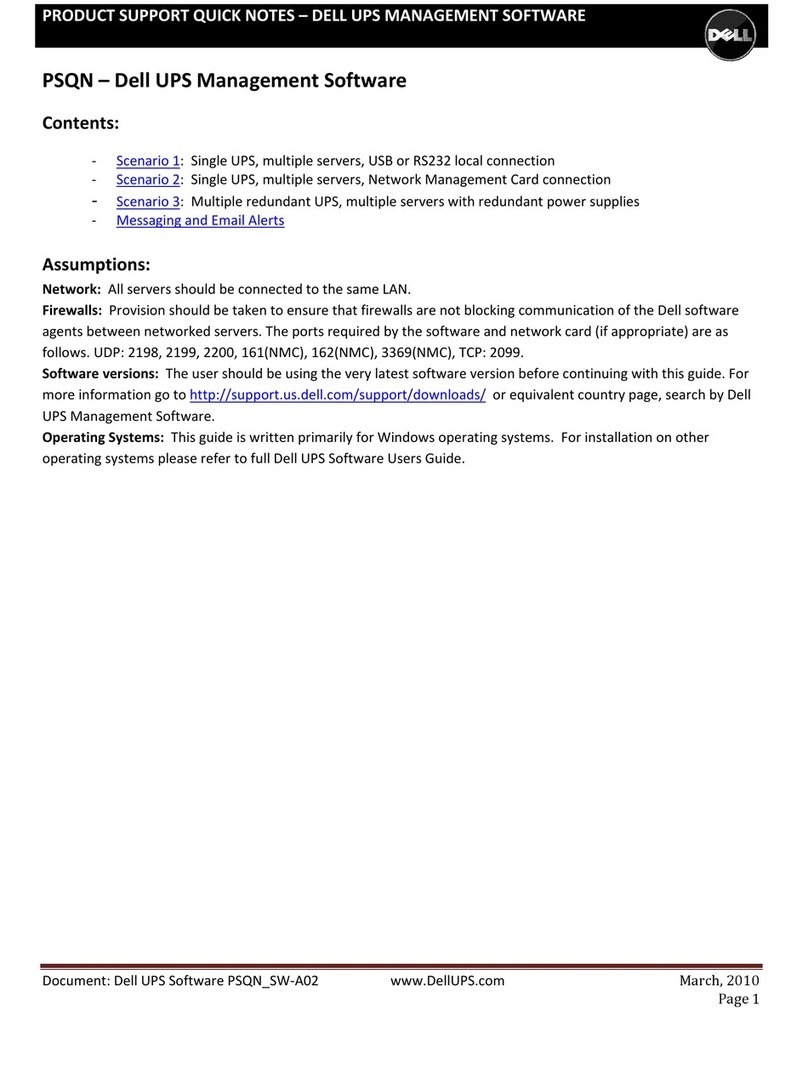TANDBERG Video Communication Server Service manual

1
D14049.05
February 2009
Video
Communication
Server
ADMINISTRATOR
GUIDE
Version X4.1
February 2009
Introduction Getting started Overview and
status
System
configuration
VCS
configuration
Zones and
neighbors
Call
processing
Bandwidth
control
Firewall
traversal Appendices
Applications Maintenance

2
D14049.05
February 2009
Grey Headline (continued)
Preamble
Legal notices........................................................................ 10
Disclaimer ...................................................................... 10
Intellectual property rights .............................................. 10
Copyright notice.............................................................. 10
Patent information .......................................................... 10
Safety instructions and approvals.......................................... 11
Safety instructions.......................................................... 11
Water and moisture................................................... 11
Cleaning ................................................................... 11
Ventilation ................................................................ 11
Lightning .................................................................. 11
Dust......................................................................... 11
Vibration................................................................... 11
Power connection and hazardous voltage ................... 11
Servicing .................................................................. 11
Accessories.............................................................. 11
Approvals ....................................................................... 11
Electromagnetic Compatibility (EMC).......................... 11
EC declaration of conformity...................................... 11
JATE approval (Japan only)......................................... 11
Environmental issues............................................................ 12
TANDBERG’s environmental policy ................................... 12
European Environmental Directives.................................. 12
Waste handling .............................................................. 12
TANDBERG’s recycling policy ........................................... 12
Digital user guides .......................................................... 12
Introduction
The TANDBERG VCS.............................................................. 14
Overview ........................................................................ 14
VCS and the TANDBERG Total Solution............................. 14
Initial configuration ............................................................... 22
Powering on the VCS....................................................... 22
Initial configuration using a serial cable ........................... 22
Initial configuration using the front panel ......................... 23
System administration access............................................... 24
Overview ........................................................................ 24
About administration access ..................................... 24
Security considerations............................................. 24
Configuring administration access ............................. 24
Administration session timeout ................................. 24
Administrator accounts ................................................... 25
Default administrator account ................................... 25
Changing the default administrator account password 25
Root account ........................................................... 25
Changing the root account password ......................... 25
Accessing the root account over SSH and Telnet ........ 25
Administrator password security ................................ 25
Resetting a forgotten administrator or root password . 25
Web interface ................................................................. 26
Using the web interface............................................. 26
How page navigation is shown in this guide .......... 26
Supported browsers.................................................. 26
General page features............................................... 27
Command line interface (CLI) .......................................... 28
Using the CLI ............................................................ 28
Types of commands ............................................ 28
How CLI commands are shown in this guide ......... 28
Supported characters ..................................................... 28
Overview and status
Overview .............................................................................. 30
Overview page ................................................................ 30
VCS base applications .................................................... 15
VCS Control .............................................................. 15
VCS Expressway™ .................................................... 15
Standard features .......................................................... 16
Optional features ............................................................17
User Policy (FindMe™)................................................17
TMS Agent (Device Provisioning) .................................17
Dual Network Interfaces.............................................17
What’s new in this version? ............................................. 18
Multiway™ ................................................................ 18
TMS Agent................................................................ 18
Microsoft OCS 2007 interoperability .......................... 18
Static NAT support.................................................... 18
Password security..................................................... 18
Root account access................................................. 18
Capacity warnings..................................................... 18
Clustering................................................................. 18
Call processing ......................................................... 18
Administrator tools ................................................... 18
Usability enhancements ............................................ 18
Login banner............................................................. 18
The Administrator Guide........................................................ 19
Using this Administrator Guide ........................................ 19
Typographical conventions......................................... 19
Web interface ..................................................... 19
Command line interface (CLI)............................... 19
Getting started
Installation ........................................................................... 21
What’s in the box? .......................................................... 21
Connecting the cables .................................................... 21
Installation site preparations........................................... 21
General installation precautions ...................................... 21
TANDBERG VIDEO COMMUNICATIONS SERVER
ADMINISTRATOR GUIDE
Introduction Getting started Overview and
status
System
configuration
VCS
configuration
Zones and
neighbors
Call
processing
Bandwidth
control
Firewall
traversal Appendices
Applications Maintenance
What’s in this manual?

3
D14049.05
February 2009
Grey Headline (continued)
Status.................................................................................. 31
System information......................................................... 31
Ethernet status............................................................... 31
IP status ........................................................................ 32
Resource usage.............................................................. 32
Registrations by device ................................................... 33
Registrations by alias...................................................... 33
Registration history......................................................... 34
Registration details......................................................... 34
Calls .............................................................................. 35
Call history ..................................................................... 35
Call summary ................................................................. 36
Call media ...................................................................... 36
Call details ..................................................................... 36
Searches........................................................................ 37
About searches ........................................................ 37
Search history ................................................................ 37
Search details ................................................................ 37
Local Zone ..................................................................... 38
Zones............................................................................. 38
Links.............................................................................. 39
Pipes ............................................................................. 39
STUN relays.................................................................... 40
Presence........................................................................ 40
OCS Relay ...................................................................... 41
Warnings ........................................................................ 41
Event Log ....................................................................... 42
Event Log color coding .............................................. 42
Green ................................................................. 42
Orange ............................................................... 42
Red .................................................................... 42
Event Log format....................................................... 43
Message details field................................................ 44
Events and levels...................................................... 45
SNMP............................................................................. 54
About SNMP ............................................................. 54
Logging .......................................................................... 55
Overview .................................................................. 55
About Event Log levels .............................................. 55
Setting the Event Log level ........................................ 55
About remote logging ................................................ 55
Enabling remote logging ............................................ 55
VCS configuration
H.323 .................................................................................. 57
H.323 overview .............................................................. 57
About H.323 on the VCS ........................................... 57
Using the VCS as an H.323 gatekeeper ..................... 57
H.323 endpoint registration ............................................ 57
Configuring H.323........................................................... 58
Enabling H.323 ......................................................... 58
Configuring H.323 ports ............................................ 58
Registration conflict mode......................................... 58
Time to live............................................................... 58
Call time to live......................................................... 58
Auto discover............................................................ 58
SIP....................................................................................... 59
SIP overview ................................................................... 59
About SIP on the VCS................................................ 59
Using the VCS as a SIP registrar................................ 59
Proxying registration requests ............................. 59
Using the VCS as a SIP proxy server .......................... 59
Using the VCS as a SIP Presence Server.................... 60
SIP endpoint registration................................................. 60
Movi v2.0 clients ...................................................... 60
Configuration Log............................................................ 49
Types of Configuration Log events.............................. 49
Administrator sessions ....................................... 49
FindMe user sessions ......................................... 49
Configuration changes......................................... 49
System configuration
System configuration ............................................................ 51
System administration .................................................... 51
About the system name ........................................... 51
About administration access settings ....................... 51
Ethernet ......................................................................... 51
About Ethernet speed ............................................... 51
IP................................................................................... 52
About IP protocols .................................................... 52
About IPv4 to IPv6 gatewaying ................................... 52
About LAN configuration ............................................ 52
About Dual Network Interfaces .................................. 52
About static NAT ....................................................... 52
About IP routes (static routes) ................................... 52
DNS ............................................................................... 53
About DNS servers ................................................... 53
About the DNS domain name..................................... 53
Time .............................................................................. 53
About the NTP server ................................................ 53
About the time zone .................................................. 53
System time ............................................................. 53
Local time ................................................................ 53
Daylight saving/summer time .................................... 53
Login page ..................................................................... 54
External manager............................................................ 54
About external managers .......................................... 54
Configuration ............................................................ 54
TANDBERG VIDEO COMMUNICATIONS SERVER
ADMINISTRATOR GUIDE
Introduction Getting started Overview and
status
System
configuration
VCS
configuration
Zones and
neighbors
Call
processing
Bandwidth
control
Firewall
traversal Appendices
Applications Maintenance
What’s in this manual?

4
D14049.05
February 2009
Grey Headline (continued)
Configuring SIP ............................................................... 61
Enabling SIP ............................................................. 61
SIP registration expiry ............................................... 61
SIP registration proxy mode....................................... 61
SIP protocols and ports............................................. 61
SIP domains ................................................................... 61
Interworking ......................................................................... 62
Overview ........................................................................ 62
Configuring interworking.................................................. 62
H.323 <-> SIP interworking mode .............................. 62
Enabling SIP endpoints to dial H.323 numbers........... 62
Registration control .............................................................. 63
Registration overview...................................................... 63
Endpoint registration................................................. 63
Registrations on a VCS Expressway ........................... 63
MCU, gateway and Content Server registration ........... 63
Finding a VCS with which to register........................... 64
SIP ..................................................................... 64
H.323................................................................. 64
Preventing automatic registrations....................... 64
Authentication ................................................................ 65
Authentication mode ................................................. 65
Authentication database ........................................... 65
External registration credentials ................................ 65
Authentication using LDAP .............................................. 66
Overview .................................................................. 66
Configuring the LDAP server directory................... 66
Securing the LDAP connection with TLS .............. 66
Alias origin ............................................................... 67
LDAP .................................................................. 67
Combined........................................................... 67
Endpoint............................................................. 67
Traversal client zone ....................................................... 76
Traversal server zone ...................................................... 76
ENUM zone..................................................................... 77
DNS zone ....................................................................... 77
Default Zone................................................................... 77
Adding zones .................................................................. 78
Name ....................................................................... 78
Type ......................................................................... 78
Configuring zones - common options................................ 78
Hop count................................................................. 78
Match 1 - Match 5..................................................... 78
Configuring neighbor zones ............................................. 79
Protocol.................................................................... 79
Location ................................................................... 79
Advanced ................................................................. 79
Configuring traversal client zones .................................... 81
Authentication username .......................................... 81
Protocol.................................................................... 81
Advanced ................................................................. 81
Client settings .......................................................... 81
Location ................................................................... 81
Configuring traversal server zones ................................... 82
Client authentication username ................................. 82
Protocol.................................................................... 82
Advanced ................................................................. 82
UDP/TCP probes....................................................... 82
Configuring ENUM zones ................................................. 83
DNS settings ............................................................ 83
Protocol.................................................................... 83
Configuring DNS zones.................................................... 83
Protocol.................................................................... 83
Advanced ................................................................. 83
Authentication using a local database ............................. 68
Overview .................................................................. 68
Configuring the local authentication database ............ 68
Registering aliases ......................................................... 69
About alias registration ............................................. 69
H.323................................................................. 69
SIP ..................................................................... 69
Attempts to register using an existing alias ................ 69
H.323................................................................. 69
SIP ..................................................................... 69
Blocking registrations ............................................... 69
Allow and Deny Lists ....................................................... 70
About Allow and Deny Lists ....................................... 70
Patterns and pattern types.................................. 70
Activating use of Allow or Deny Lists .......................... 70
Removing existing registrations ................................. 70
Managing entries in the Allow List...............................71
Managing entries in the Deny List...............................71
Zones and neighbors
Introduction.......................................................................... 73
About your video communications network....................... 73
Example network diagram ......................................... 73
Local Zone and subzones.......................................................74
Overview .........................................................................74
Configuring the Local Zone and its subzones.....................74
Bandwidth management.............................................74
Local Zone matches...................................................74
Traversal Subzone........................................................... 75
What are traversal calls?........................................... 75
Configuring the Traversal Subzone ports .................... 75
Zones .................................................................................. 76
About zones ................................................................... 76
Neighbor zone ................................................................ 76
TANDBERG VIDEO COMMUNICATIONS SERVER
ADMINISTRATOR GUIDE
Introduction Getting started Overview and
status
System
configuration
VCS
configuration
Zones and
neighbors
Call
processing
Bandwidth
control
Firewall
traversal Appendices
Applications Maintenance
What’s in this manual?

5
D14049.05
February 2009
Grey Headline (continued)
Clustering and peers............................................................. 85
About clustering.............................................................. 85
About the configuration master.................................. 85
Configuring clusters ........................................................ 86
Prerequisites ............................................................ 86
Enabling H.323 ......................................................... 86
Enabling SSH............................................................ 86
Running the clustering script ..................................... 86
Setting configuration for the cluster ........................... 86
Changing the master ................................................. 86
Using TMS ................................................................ 86
Listing other peers in the cluster ............................... 86
What configuration is and isn’t replicated?....................... 87
System name ........................................................... 87
Administrator accounts ............................................. 87
Option keys .............................................................. 87
Ethernet speed ......................................................... 87
Conference Factory template..................................... 87
IP configuration ........................................................ 87
DNS configuration ..................................................... 87
Logging .................................................................... 87
FindMe database ...................................................... 87
Sharing registrations across peers .................................. 87
H.323 registrations................................................... 87
SIP registrations ....................................................... 87
Sharing bandwidth across peers...................................... 87
Clustering and FindMe .................................................... 88
Overview .................................................................. 88
Configuration ............................................................ 88
Enabling the replication of FindMe information ..... 88
Enabling SSH...................................................... 88
Clustering and presence ................................................. 88
Backup and restore......................................................... 88
Pre-search transforms .................................................... 96
About pre-search transforms ..................................... 96
Pre-search transform process ................................... 96
Configuring pre-search transforms ............................. 96
Zone searching and transforming ................................... 97
About zone searching................................................ 97
Match mode ....................................................... 97
Match priority ..................................................... 97
About zone transforms .............................................. 97
Using zone searches and transforms together............ 97
Zone search and transform process .......................... 97
Configuring zone searches and transforms................. 98
Local Zone.......................................................... 98
External zones .................................................... 98
Match options .......................................................... 98
Default settings ........................................................ 98
Examples ....................................................................... 99
Stripping @domain for dialing to H.323 numbers ........ 99
Combining match types and priorities ...................... 100
Never query a zone ................................................. 100
Always query a zone, never apply transforms............ 100
Filter queries to a zone without transforming............ 101
Query a zone for original and transformed alias........ 102
Query a zone for two or more transformed aliases .... 103
Call Policy........................................................................... 104
About Call Policy .......................................................... 104
Call Policy and authentication........................................ 104
Authentication mode off.......................................... 104
Authentication mode on .......................................... 104
H.323............................................................... 104
SIP ................................................................... 104
Enabling Call Policy ....................................................... 105
Upgrades and downgrades .............................................. 88
Upgrading to X3.0 or later ......................................... 88
Downgrading from X3.0 or later ................................. 88
Cluster Subzone ............................................................. 89
Neighboring the local VCS to another VCS cluster............. 89
Overview .................................................................. 89
Configuration ............................................................ 89
Dial plans............................................................................. 90
About dial plans.............................................................. 90
Flat dial plan................................................................... 90
Structured dial plan ........................................................ 90
Hierarchical dial plan ...................................................... 90
Call processing
Introduction.......................................................................... 92
Call processing diagram.................................................. 92
VCS search process.................................................. 92
Dialing by address types ....................................................... 93
About the different address types ................................... 93
Dialing by IP address ...................................................... 93
Endpoints registered to a VCS Expressway................. 93
Dialing by H.323 ID or E.164 alias ................................... 93
Dialing by H.323 or SIP URI ............................................. 93
Dialing by ENUM ............................................................. 93
Hop counts........................................................................... 94
About hop counts ........................................................... 94
Configuring hop counts.................................................... 94
Searches and transforms...................................................... 95
Overview of searches and transforms .............................. 95
About searches ........................................................ 95
About transforms ...................................................... 95
TANDBERG VIDEO COMMUNICATIONS SERVER
ADMINISTRATOR GUIDE
Introduction Getting started Overview and
status
System
configuration
VCS
configuration
Zones and
neighbors
Call
processing
Bandwidth
control
Firewall
traversal Appendices
Applications Maintenance
What’s in this manual?

6
D14049.05
February 2009
Grey Headline (continued)
Configuring basic Call Policy using the web interface ...... 105
Configuring Call Policy using a CPL script ....................... 106
Overview ................................................................ 106
Viewing existing CPL script ...................................... 106
About CPL XSD files ................................................ 106
Uploading a CPL script ............................................ 106
Deleting an existing CPL script ................................ 106
URI dialing...........................................................................107
Overview .......................................................................107
URI dialing without DNS ...........................................107
URI dialing via DNS ..................................................107
Enabling URI dialing via DNS ..........................................107
URI resolution process using DNS ................................. 108
H.323 .................................................................... 108
SIP ......................................................................... 108
URI dialing via DNS for outgoing calls ............................ 109
Process.................................................................. 109
Adding and configuring DNS zones........................... 109
Configuring matches for DNS zones ................... 109
Configuring DNS servers ......................................... 109
URI dialing via DNS for incoming calls ............................ 110
Types of DNS records required ................................ 110
Process.................................................................. 110
SRV record format ................................................. 110
Configuring H.323 SRV records................................ 110
Location SRV records ........................................ 110
Call SRV records ............................................... 110
Configuring SIP SRV records .................................... 110
Example DNS record configuration ........................... 111
Firewall traversal .......................................................... 111
Recommended configuration ................................... 111
ENUM dialing...................................................................... 112
Overview ...................................................................... 112
Process........................................................................ 112
Call IDs, Serial Numbers and Tags....................................... 118
Identifying a particular call ............................................ 118
Call ID .................................................................... 118
Call Serial Number .................................................. 118
Call Tag .................................................................. 118
Identifying calls in the web interface ........................ 118
Identifying calls in the CLI ....................................... 118
Disconnecting calls............................................................. 119
Disconnecting a call using the web interface.................. 119
Disconnecting a call using the CLI ................................. 119
Issues when disconnecting SIP calls.............................. 119
Bandwidth control
Bandwidth control overview................................................. 121
Bandwidth control on the VCS ....................................... 121
Example network deployment ........................................ 121
Subzones ........................................................................... 122
About subzones and bandwidth control.......................... 122
About the Traversal Subzone ......................................... 122
Traversal calls ........................................................ 122
Bandwidth consumption of traversal calls ................ 122
About the Default Subzone............................................ 122
Default links between subzones .................................... 122
Creating a subzone ....................................................... 123
Configuring a subzone ................................................... 123
Applying bandwidth limitations to subzones ................... 124
Types of limitations................................................. 124
How different bandwidth limitations are managed .... 124
Enabling ENUM dialing .................................................. 112
ENUM dialing for outgoing calls ..................................... 113
Prerequisites .......................................................... 113
Process.................................................................. 113
Example ................................................................. 113
Adding and configuring ENUM zones ........................ 114
Configuring matches for ENUM zones....................... 114
Example ........................................................... 114
Configuring transforms for ENUM zones ................... 114
Example ........................................................... 114
Configuring DNS servers ......................................... 114
ENUM dialing for incoming calls..................................... 115
Prerequisites .......................................................... 115
About DNS domains for ENUM................................. 115
Configuring DNS NAPTR records .............................. 115
Example ................................................................. 115
IP dialing ............................................................................ 116
About unregistered endpoints........................................ 116
Calls to unknown IP addresses...................................... 116
Overview ................................................................ 116
About unknown IP addresses .................................. 116
Configuration .......................................................... 116
Direct ............................................................... 116
Indirect............................................................. 116
Off ................................................................... 116
Recommended configuration for firewall traversal .... 116
Call configuration.................................................................117
Call routed mode ...........................................................117
Overview .................................................................117
Call loop detection mode ...............................................117
Overview .................................................................117
Fallback alias ................................................................117
Overview .................................................................117
Example usage ........................................................117
TANDBERG VIDEO COMMUNICATIONS SERVER
ADMINISTRATOR GUIDE
Introduction Getting started Overview and
status
System
configuration
VCS
configuration
Zones and
neighbors
Call
processing
Bandwidth
control
Firewall
traversal Appendices
Applications Maintenance
What’s in this manual?

7
D14049.05
February 2009
Grey Headline (continued)
Links.................................................................................. 125
About links ................................................................... 125
Default links ........................................................... 125
Creating and editing links .............................................. 125
Creating a new link.................................................. 125
Editing an existing link ............................................ 125
Link configuration options ....................................... 125
Default links ................................................................. 125
About default links .................................................. 125
Pre-configured links................................................. 125
Automatically created links...................................... 125
Pipes ................................................................................. 126
About pipes .................................................................. 126
Creating and editing pipes............................................. 126
Creating a new pipe ................................................ 126
Editing an existing pipe ........................................... 126
Pipe configuration options ....................................... 126
Applying pipes to links .................................................. 127
One pipe, one link ................................................... 127
One pipe, two or more links..................................... 127
Example ........................................................... 127
Two pipes, one link ................................................. 127
Example ........................................................... 127
Default bandwidth and downspeeding.................................. 128
About the default call bandwidth ................................... 128
About downspeeding..................................................... 128
Configuring default call bandwidth and downspeeding .... 128
Bandwidth control examples ............................................... 129
Example without a firewall ............................................. 129
Example with a firewall.................................................. 130
VCS Expressway subzone configuration.................... 130
VCS Control subzone configuration .......................... 130
Adding and configuring a traversal client zone ................ 138
Configuring the VCS as a traversal server ............................ 139
Overview ...................................................................... 139
Adding and configuring a traversal server zone ............... 139
Configuring traversal for endpoints ................................ 139
Overview ................................................................ 139
Configuring traversal server ports .................................. 140
Overview ................................................................ 140
Configuration .......................................................... 140
STUN services ...............................................................141
About STUN .............................................................141
About ICE ................................................................141
STUN Binding Discovery ...........................................141
How it works ......................................................141
STUN Relay..............................................................141
How it works ......................................................141
Configuring STUN services .......................................141
Applications
Conference Factory............................................................. 143
Overview ...................................................................... 143
Process.................................................................. 143
Configuration ................................................................ 143
Presence............................................................................ 144
Overview ...................................................................... 144
Presence Server ........................................................... 144
Presence User Agent (PUA)............................................ 145
Overview ................................................................ 145
Aggregation of presence information ....................... 145
FindMe presence .............................................. 145
Registration refresh period...................................... 145
Firewall traversal
Firewall traversal overview................................................... 132
About Expressway™...................................................... 132
How does it work? .................................................. 132
VCS as a firewall traversal client.................................... 132
VCS as a firewall traversal server................................... 132
Quick guide to VCS traversal client - server configuration ...... 133
Overview ...................................................................... 133
VCS Control (client)....................................................... 133
VCS Expressway (server) ............................................... 133
Firewall traversal protocols and ports .................................. 134
Overview ...................................................................... 134
Expressway process ..................................................... 134
H.323 firewall traversal protocols .................................. 134
SIP firewall traversal protocols....................................... 134
Ports for initial connections from traversal clients .......... 135
Assent ports................................................................. 135
Call signaling .......................................................... 135
Media..................................................................... 135
SIP ports ...................................................................... 135
Call signaling .......................................................... 135
Media..................................................................... 135
H.460.18/19 ports....................................................... 135
Call signaling .......................................................... 135
Media..................................................................... 135
STUN ports................................................................... 135
Ports for connections out to the public internet .............. 135
Firewall traversal and authentication ................................... 136
Overview ...................................................................... 136
Authentication and NTP................................................. 136
Other issues....................................................................... 137
Firewall traversal and Dual Network Interfaces ............... 137
Firewall configuration .................................................... 137
Configuring the VCS as a traversal client.............................. 138
TANDBERG VIDEO COMMUNICATIONS SERVER
ADMINISTRATOR GUIDE
Introduction Getting started Overview and
status
System
configuration
VCS
configuration
Zones and
neighbors
Call
processing
Bandwidth
control
Firewall
traversal Appendices
Applications Maintenance
What’s in this manual?

8
D14049.05
February 2009
Grey Headline (continued)
Configuring Presence .................................................... 146
Enabling and disabling Presence Services................ 146
PUA ................................................................. 146
Presence Server ............................................... 146
Recommendations ............................................ 146
Presence Server expiration times ............................ 146
Viewing presence status ................................................147
Publishers ...............................................................147
Presentities ............................................................147
Subscribers .............................................................147
OCS Relay .......................................................................... 148
Overview ...................................................................... 148
Configuring OCS Relay................................................... 148
VCS Configuration ................................................... 148
Other requirements................................................. 148
Viewing OCS Relay status.............................................. 148
FindMe™ (User Policy)......................................................... 149
Overview ...................................................................... 149
What is FindMe? ..................................................... 149
How are devices specified? ..................................... 149
Process overview .................................................... 149
Who must do what before FindMe™ can be used? .... 149
Recommendations when deploying FindMe .............. 149
Example ........................................................... 149
User Policy Manager ............................................... 149
Enabling FindMe on the VCS.......................................... 150
Configuring the User Policy Manager ........................ 150
Managing FindMe user accounts ................................... 151
About user accounts ............................................... 151
Creating a new user account ................................... 151
Viewing existing user account settings ..................... 151
Changing a user password ...................................... 151
Disabling a user account ......................................... 151
Deleting a user account .......................................... 151
TANDBERG FindMe™ user guide .......................................... 152
About FindMe ............................................................... 152
FindMe user accounts............................................. 152
Individual versus group FindMe ............................... 152
Accessing the FindMe configuration page....................... 152
Configuring your FindMe user account............................ 153
Maintenance
Upgrading software............................................................. 155
Overview ...................................................................... 155
Prerequisites .......................................................... 155
Backing up before upgrading ................................... 155
Versions prior to X3.0........................................ 155
Version X3.0 and later....................................... 155
Upgrading and option keys ...................................... 155
Installing and restarting .......................................... 155
Upgrading using the web interface................................. 156
Upgrading using SCP/PSCP ........................................... 156
Downgrading software ........................................................ 157
Downgrade procedure ................................................... 157
Prerequisites .......................................................... 157
Backing up current configuration........................ 157
Impact on new features................................................. 157
Downgrades to version X3....................................... 157
Root account password ..................................... 157
Root account access......................................... 157
Downgrades to versions prior to X3 ......................... 157
Encrypted passwords ........................................ 157
Clustering......................................................... 157
Call tags ........................................................... 157
Logging levels................................................... 157
Option keys ........................................................................ 158
Overview ...................................................................... 158
Adding option keys using the web interface.................... 158
Adding option keys using the CLI ................................... 158
Security ............................................................................. 159
Overview ...................................................................... 159
Enabling security .......................................................... 159
Trusted CA certificate.............................................. 159
Server certificate data............................................. 159
Administrator accounts ....................................................... 160
Overview ...................................................................... 160
Default administrator account ................................. 160
Additional administrator accounts............................ 160
Administrator password security .............................. 160
Adding and editing an administrator account .................. 160
Backup and restore ............................................................ 161
Overview ...................................................................... 161
Limitations ............................................................. 161
Creating a backup of your VCS configuration .................. 161
Restoring a previous backup ......................................... 161
System snapshot................................................................ 162
Overview ...................................................................... 162
Creating a system snapshot .......................................... 162
Incident reporting ............................................................... 163
Overview ...................................................................... 163
Warning: privacy-protected personal data................. 163
What information does the report contain? .................... 163
Viewing incident reports................................................ 164
Viewing a list of all incidents ................................... 164
Viewing details of a particular incident..................... 164
Sending incident reports manually................................. 164
Removing sensitive information from the report ....... 164
Sending incident reports automatically .......................... 164
TANDBERG VIDEO COMMUNICATIONS SERVER
ADMINISTRATOR GUIDE
Introduction Getting started Overview and
status
System
configuration
VCS
configuration
Zones and
neighbors
Call
processing
Bandwidth
control
Firewall
traversal Appendices
Applications Maintenance
What’s in this manual?

9
D14049.05
February 2009
Grey Headline (continued)
Tools.................................................................................. 165
Check pattern............................................................... 165
Locate.......................................................................... 165
Port usage.................................................................... 166
Overview ................................................................ 166
Local VCS inbound ports ......................................... 166
Local VCS outbound ports....................................... 166
Remote listening ports ............................................ 166
Restarting and shutting down.............................................. 167
Restarting .................................................................... 167
Restarting using the web interface .......................... 167
Restarting using the CLI .......................................... 167
Shutting down .............................................................. 167
Shutting down using the web interface..................... 167
Shutting down using the CLI .................................... 167
Restoring default configuration ............................................ 168
Overview ...................................................................... 168
DefaultValuesSet level 3 ............................................... 168
Password encryption............................................................171
Overview .......................................................................171
Web interface ..........................................................171
Command line interface (CLI) ...................................171
Maximum length of passwords .......................................171
Appendices
CPL reference......................................................................173
Overview of CPL on the VCS ...........................................173
address-switch ..............................................................173
Overview .................................................................173
address ..................................................................173
field......................................................................... 174
subfield ...................................................................175
otherwise ......................................................................175
not-present....................................................................175
location.........................................................................176
rule-switch.....................................................................176
proxy ............................................................................176
reject ...........................................................................176
Unsupported CPL elements............................................176
CPL examples................................................................177
Call screening of authenticated users .......................177
Call screening based on alias ...................................177
Call screening based on domain ...............................178
Change of domain name...........................................178
Allow calls from locally registered endpoints only ......179
Block calls from Default Zone and Default Subzone...179
Restricting access to a local gateway....................... 180
Using the address-switch node .......................... 180
Using the rule-switch node ................................ 180
Redirecting failed calls based on status code........... 181
Regular expression reference .............................................. 182
Overview ...................................................................... 182
Common regular expressions ........................................ 182
Pattern variable reference ................................................... 183
Overview ...................................................................... 183
Valid variable strings..................................................... 183
VCS port reference ............................................................. 184
Overview ...................................................................... 184
VCS ports..................................................................... 184
DNS configuration............................................................... 187
Overview ...................................................................... 187
Verifying the SRV record.......................................... 187
Microsoft DNS server.................................................... 187
BIND 8 & 9 .................................................................. 187
LDAP configuration.............................................................. 188
About the LDAP databases............................................ 188
Downloading the H.350 schemas .................................. 188
Microsoft Active Directory ............................................ 188
Prerequisites ......................................................... 188
Installing the H.350 schemas.................................. 188
Adding H.350 objects ............................................ 189
Create the organizational hierarchy ................... 189
Add the H.350 objects ..................................... 189
Securing with TLS .................................................. 189
OpenLDAP .................................................................... 190
Prerequisites ......................................................... 190
Installing the H.350 schemas ................................. 190
Adding H.350 objects ............................................ 191
Create the organizational hierarchy ................... 191
Add the H.350 objects ..................................... 191
Securing with TLS .................................................. 191
Command reference - xConfiguration ................................... 192
Command reference - xCommand ........................................ 228
Command reference - xStatus ............................................. 242
Bibliography ....................................................................... 260
Glossary............................................................................. 261
Contact information ............................................................ 266
TANDBERG VIDEO COMMUNICATIONS SERVER
ADMINISTRATOR GUIDE
Introduction Getting started Overview and
status
System
configuration
VCS
configuration
Zones and
neighbors
Call
processing
Bandwidth
control
Firewall
traversal Appendices
Applications Maintenance
What’s in this manual?

Preamble
10
D14049.05
February 2009
Grey Headline (continued)
TANDBERG VIDEO COMMUNICATIONS SERVER
ADMINISTRATOR GUIDE
Introduction Getting started Overview and
status
System
configuration
VCS
configuration
Zones and
neighbors
Call
processing
Bandwidth
control
Firewall
traversal Appendices
Applications Maintenance
Legal notices
The specifications for the product and the
information in this Administrator Guide are
subject to change at any time, without notice,
by TANDBERG.
Every effort has been made to supply complete
and accurate information in this Administrator
Guide, however, TANDBERG assumes no
responsibility or liability for any errors or
inaccuracies that may appear in this document.
This product is covered by one or more of the
following patents:
EP01953201
•
GB1338127
•
Other patents pending. Contact
tandberg@tandberg.com for an up-to-date list.
Disclaimer Copyright notice Patent information
The product that is covered by this
Administrator Guide is protected under
copyright, patent, and other intellectual
property rights of various jurisdictions.
This product is
Copyright © 2009, Tandberg Telecom AS.
All rights reserved.
This product includes copyrighted software
licensed from others. A list of the copyright
notices and the terms and conditions of use
can be found at:
http://www.tandberg.com/collateral/
documentation/User_Manuals/TANDBERG VCS
EULA.pdf
and
http://www.tandberg.com/collateral/
documentation/User_Manuals/TANDBERG VCS
Copyrights.pdf.
IMPORTANT: USE OF THIS PRODUCT IS
SUBJECT IN ALL CASES TO THE COPYRIGHT
RIGHTS AND THE TERMS AND CONDITIONS
OF USE REFERRED TO ABOVE. USE OF THIS
PRODUCT CONSTITUTES AGREEMENT TO SUCH
TERMS AND CONDITIONS.
This Administrator Guide and the product to
which it relates contain information that is
proprietary to TANDBERG and its licensors.
Information regarding the product is found
adjacent in the Copyright notice and Patent
information sections.
This Administrator Guide may be reproduced
in its entirety, including all copyright and
intellectual property notices, in limited
quantities in connection with the use of the
product. Except for the limited exception set
forth in the previous sentence, no part of
this Administrator Guide may be reproduced,
stored in a retrieval system, or transmitted,
in any form, or by any means, electronically,
mechanically, by photocopying, or otherwise,
without the prior written permission of
TANDBERG. Requests for such permission
should be addressed to ipr@tandberg.com.
TANDBERG® is a registered trademark
belonging to Tandberg ASA. Other trademarks
used in this document are the property of their
respective holders.
COPYRIGHT © 2009, TANDBERG
All rights reserved.
Philip Pedersens vei 22
1366 Lysaker
Norway
Tel: +47 67 125 125
Fax: +47 67 125 234
Email: tandberg@tandberg.com
Intellectual property rights

11
D14049.05
February 2009
Grey Headline (continued)
TANDBERG VIDEO COMMUNICATIONS SERVER
ADMINISTRATOR GUIDE
Introduction Getting started Overview and
status
System
configuration
VCS
configuration
Zones and
neighbors
Call
processing
Bandwidth
control
Firewall
traversal Appendices
Applications Maintenance
Safety instructions and approvals
For your protection please read these safety
instructions completely before you connect
the equipment to the power source. Carefully
observe all warnings, precautions and
instructions both on the apparatus and in these
operating instructions. Retain this manual for
future reference.
Water and moisture
Do not operate the apparatus under or near
• water – for example near a bathtub, kitchen
sink, or laundry tub, in a wet basement, near
a swimming pool or in other areas with high
humidity.
Never install jacks for communication cables
• in wet locations unless the jack is specifically
designed for wet locations.
Do not touch the product with wet hands.
•
Cleaning
Unplug the apparatus from communication
• lines, mains power-outlet or any power
source before cleaning or polishing.
Do not use liquid cleaners or aerosol
• cleaners. Use a lint-free cloth lightly
moistened with water for cleaning the exterior
of the apparatus.
Ventilation
Do not block any of the ventilation openings
• of the apparatus. Never cover the slots and
openings with a cloth or other material. Never
install the apparatus near heat sources such
as radiators, heat registers, stoves, or other
apparatus (including amplifiers) that produce
heat.
Do not place the product in direct sunlight or
• close to a surface directly heated by the sun.
Lightning
Never use this apparatus, or connect or
disconnect communication cables or power
cables during lightning storms.
Dust
Do not operate the apparatus in areas with high
concentration of dust.
Vibration
Do not operate the apparatus in areas with
vibration or place it on an unstable surface.
Power connection and
hazardous voltage
The product may have hazardous voltage
• inside. Never attempt to open this product,
or any peripherals connected to the product,
where this action requires a tool.
This product should always be powered from
• an earthed power outlet.
Never connect attached power supply cord to
• other products.
In case any parts of the product has visual
• damage never attempt to connect mains
power, or any other power source, before
consulting service personnel
The plug connecting the power cord to the
• product/power supply serves as the main
disconnect device for this equipment. The
power cord must always be easily accessible.
Route the power cord so as to avoid it being
• walked on or pinched by items placed upon
or against it. Pay particular attention to the
plugs, receptacles and the point where the
cord exits from the apparatus.
Do not tug the power cord.
•
If the provided plug does not fit into your
• outlet, consult an electrician.
Never install cables, or any peripherals,
• without first unplugging the device from it's
power source.
Servicing
Do not attempt to service the apparatus
• yourself as opening or removing covers may
expose you to dangerous voltages or other
hazards, and will void the warranty. Refer all
servicing to qualified service personnel.
Unplug the apparatus from its power source
• and refer servicing to qualified personnel
under the following conditions:
If the power cord or plug is damaged or
•
frayed.
If liquid has been spilled into the
•
apparatus.
If objects have fallen into the apparatus.
•
If the apparatus has been exposed to rain
•
or moisture
If the apparatus has been subjected to
•
excessive shock by being dropped.
If the cabinet has been damaged.
•
If the apparatus seems to be overheated.
•
If the apparatus emits smoke or abnormal
•
odor.
If the apparatus fails to operate in
•
accordance with the operating instructions.
Accessories
Use only accessories specified by the
manufacturer, or sold with the apparatus.
Electromagnetic Compatibility (EMC)
This is a Class A product. In a domestic
environment this product may cause radio
interference in which case the user may be
required to take adequate measures.
EC declaration of conformity
Manufacturer: TANDBERG Telecom AS
Product Name: TANDBERG Video
Communication Server
Type Number: TTC2-04
Description: Network unit
This product complies with Commission
Directives:
LVD 73/23/EEC
• EMC 89/336/EEC
• RoHS 2002/95/EEC
•
This product complies with harmonized
Standards:
EN 55022 : 2005, (Class A limits)
• EN 55024 : 1998, A1:2001, A2:2003
• EN 61000-3-2 :2000, A2 : 2005
• EN 61000-3-2 : 1995, A1 : 2001
• EN 55024 : 1998, A1 : 2001, A2 : 2003
•
Technical Construction File No.: X14182
Year which the CE mark was affixed: 2007
For an official, signed version of this document,
or details regarding documentation from the
technical construction file, please contact
TANDBERG.
JATE approval (Japan only)
This unit must be connected to the public
internet via a router/switch that has JATE
approval.
ApprovalsSafety instructions

12
D14049.05
February 2009
Grey Headline (continued)
TANDBERG VIDEO COMMUNICATIONS SERVER
ADMINISTRATOR GUIDE
Introduction Getting started Overview and
status
System
configuration
VCS
configuration
Zones and
neighbors
Call
processing
Bandwidth
control
Firewall
traversal Appendices
Applications Maintenance
Environmental issues
Thank you for buying a product which contributes to a reduction
in pollution, and thereby helps save the environment. Our
products reduce the need for travel and transport and thereby
reduce pollution. Our products have either none or few
consumable parts (chemicals, toner, gas, paper). Our products
are low energy consuming products.
TANDBERG is pleased to announce that we have replaced the
printed versions of our User Guides with a digital CD version.
Instead of a range of different user manuals, there is now one
CD – which can be used with all TANDBERG products – in a
variety of languages. The environmental benefits of this are
significant. The CDs are recyclable and the savings on paper
are huge. A simple web-based search feature helps you directly
access the information you need. In addition, the TANDBERG
video systems now have an intuitive on-page help function,
which provides a range of useful features and tips. The contents
of the CD can still be printed locally, whenever needed.
As part of compliance with the European WEEE Directive,
TANDBERG provides recycling information on request for all
types of new equipment put on the market in Europe after
August 13th 2005.
Please contact TANDBERG and provide the following details
for the product for which you would like to receive recycling
information:
Model number of TANDBERG product
•
Your company’s name
•
Contact name
•
Address
•
Telephone number
•
E-mail
•
In order to avoid the dissemination of hazardous substances
in our environment and to diminish the pressure on natural
resources, we encourage you to use the appropriate take-back
systems in your area. Those systems will reuse or recycle most
of the materials of your end of life equipment in a sound way.
TANDBERG products put on the market after August
2005 are marked with a crossed-out wheelie bin
symbol that invites you to use those take-back
systems.
Please contact your local supplier, the regional waste
administration, or http://www.tandberg.com/recycling if you
need more information on the collection and recycling system in
your area.
As a manufacturer of electrical and electronic equipment
TANDBERG is responsible for compliance with the requirements
in the European Directives 2002/96/EC (WEEE) and 2002/95/
EC (RoHS).
The primary aim of the WEEE Directive and RoHS Directive is
to reduce the impact of disposal of electrical and electronic
equipment at end-of-life. The WEEE Directive aims to reduce
the amount of WEEE sent for disposal to landfill or incineration
by requiring producers to arrange for collection and recycling.
The RoHS Directive bans the use of certain heavy metals and
brominated flame retardants to reduce the environmental impact
of WEEE which is landfilled or incinerated.
TANDBERG has implemented necessary process changes to
comply with the European RoHS Directive (2002/95/EC) and the
European WEEE Directive (2002/96/EC).
Environmental stewardship is important to TANDBERG’s culture.
As a global company with strong corporate values, TANDBERG
is committed to following international environmental legislation
and designing technologies that help companies, individuals and
communities creatively address environmental challenges.
TANDBERG’s environmental objectives are to:
Develop products that reduce energy consumption, CO
• 2
emissions, and traffic congestion
Provide products and services that improve quality of life for
• our customers
Produce products that can be recycled or disposed of safely
• at the end of product life
Comply with all relevant environmental legislation.
•
TANDBERG’s environmental policy
European Environmental Directives TANDBERG’s recycling policy
Waste handling Digital user guides

13
D14049.05
February 2009
Grey Headline (continued)
TANDBERG VIDEO COMMUNICATIONS SERVER
ADMINISTRATOR GUIDE
Introduction Getting started Overview and
status
System
configuration
VCS
configuration
Zones and
neighbors
Call
processing
Bandwidth
control
Firewall
traversal Appendices
Applications Maintenance
Environmental issues

Introduction
14
D14049.05
February 2009
Grey Headline (continued)
TANDBERG VIDEO COMMUNICATIONS SERVER
ADMINISTRATOR GUIDE
Introduction Getting started Overview and
status
System
configuration
VCS
configuration
Zones and
neighbors
Call
processing
Bandwidth
control
Firewall
traversal Appendices
Applications Maintenance
The TANDBERG VCS
VCS and the TANDBERG Total Solution
The TANDBERG Video Communication Server
(VCS) enhances the video experience and
provides seamless communication between
SIP and H.323 devices utilizing IETF and
ITU standards. The VCS is the center of the
video communication network, and connects
all H.323 and SIP endpoints, infrastructure,
and management devices. The VCS provides
unrivaled scalability and redundancy to video
communications, and is integral to TANDBERG
interoperability with unified communications
and Voice over IP systems. The VCS can be
deployed with either the Control application
or the Expressway™ application, with various
optional packages including FindMe™, Dual
Network Interfaces and TMS Agent.
Overview

15
D14049.05
February 2009
Grey Headline (continued)
TANDBERG VIDEO COMMUNICATIONS SERVER
ADMINISTRATOR GUIDE
Introduction Getting started Overview and
status
System
configuration
VCS
configuration
Zones and
neighbors
Call
processing
Bandwidth
control
Firewall
traversal Appendices
Applications Maintenance
The TANDBERG VCS
VCS Control
The VCS Control provides internal video control and administration for all SIP and H.323 devices.
It is normally deployed within your wide area network with endpoints that are behind the same
firewalls or NAT devices.
The VCS Control replaces the need to have separate H.323 gatekeeper, SIP registrar and H.323 -
SIP gateway servers.
VCS base applications
VCS Expressway™
The VCS Expressway provides standards-based firewall traversal for SIP and H.323 devices allowing
secure firewall traversal of any firewall or NAT device. As well as all the functionality of a VCS
Control, it also provides registration of traversal-enabled devices and STUN Discovery and STUN
Relay services.
The VCS Expressway is normally deployed outside of your firewall or within the DMZ.

16
D14049.05
February 2009
Grey Headline (continued)
Standard features
H.323 gatekeeper
•
SIP Proxy/Registrar
•
SIP Presence Server
•
SIP Presence User Agent
•
SIP and H.323 support, including SIP/H.323 gatewaying
•
IPv4 and IPv6 support, including IPv4/IPv6 gatewaying
•
Bandwidth management on both a per-call and a total usage basis, configurable separately for
• calls within the local subzones and to external systems and zones
Automatic downspeeding option for calls that exceed the available bandwidth
•
URI and ENUM dialing via DNS, enabling global connectivity
•
2500 registrations
•
Up to 500 non-traversal calls
•
Up to 100 traversal calls
•
Up to 200 external zones
•
Flexible zone configuration with prefix, suffix and regex support
•
Can function as a stand-alone VCS or be neighbored with other systems such as VCSs, Border
• Controllers, gatekeepers and SIP proxies
Can be part of a cluster of up to 6 VCSs for increased capacity and redundancy
•
Intelligent Route Director for single number dialling and network failover facilities
•
Optional endpoint authentication
•
Control over which endpoints are allowed to register
•
Call Policy (also known as Administrator Policy) including support for CPL
•
Embedded setup wizard using a serial port for initial configuration
•
System administration using a web interface or RS-232, Telnet, SSH, and HTTPS
•
Can be managed with TANDBERG Management Suite 12 or later
•
Pre-configured defaults for Microsoft Office Communications Server (OCS) 2007 neighbor zones
•
TANDBERG VIDEO COMMUNICATIONS SERVER
ADMINISTRATOR GUIDE
Introduction Getting started Overview and
status
System
configuration
VCS
configuration
Zones and
neighbors
Call
processing
Bandwidth
control
Firewall
traversal Appendices
Applications Maintenance
The TANDBERG VCS

17
D14049.05
February 2009
Grey Headline (continued)
The following features are available on the VCS by the purchase and installation of the appropriate
option key:
User Policy (FindMe™)
A unique industry solution that gives individual video users a single alias on which they can be
contacted regardless of location. Users have the ability to log on to a Web-based interface and
control where and how they are contacted. The FindMe feature also includes support for Microsoft
Office Communications Server (OCS) 2007, enabling FindMe aliases to register as Microsoft Office
Communicator (MOC) clients, and MOC clients to view the presence status of FindMe aliases.
TMS Agent (Device Provisioning)
Installing the “Device Provisioning” option key on the VCS enables the TMS Agent feature. The TMS
Agent allows TANDBERG Movi™ v2.0 clients registered to the VCS to be provisioned with phonebook
and configuration information by connecting to the VCS rather than directly to TMS. All phonebook
and configuration data is managed in TMS, and distributed to the clients through the TMS Agent
running on the VCS. The TMS Agent on the VCS also provides TMS with the Movi client’s status.
There is no configuration associated with the TMS Agent on the VCS – it is either on or off,
depending on whether or not the option key is installed. See the TMS documentation and the
TANDBERG Provisioning Directory Deployment Guide [26].
Dual Network Interfaces
Enables the LAN 2 ethernet port on the VCS Expressway, allowing you to have a secondary IP
address for your VCS.
This option also includes support for deployments where a VCS Expressway is located behind a
static NAT device, allowing it to have separate public and private IP addresses.
This configuration is intended for high-security deployments where the VCS Expressway is located in
a DMZ between two separate firewalls on separate network segments.
Optional features
TANDBERG VIDEO COMMUNICATIONS SERVER
ADMINISTRATOR GUIDE
Introduction Getting started Overview and
status
System
configuration
VCS
configuration
Zones and
neighbors
Call
processing
Bandwidth
control
Firewall
traversal Appendices
Applications Maintenance
The TANDBERG VCS

18
D14049.05
February 2009
Grey Headline (continued)
The following features have been introduced in version X4 of the
VCS software:
Multiway™
VCS now supports standards-based Multiway™. This feature
allows endpoint users to initiate ad hoc multiparty calls from
their endpoint, -even if the endpoint does not have embedded
MultiSite™ capabilities. To enable this feature you must enable
and configure the Conference Factory application on the VCS -
see the Conference Factory section for further information.
TMS Agent
The TMS Agent allows TANDBERG Movi™ v2.0 clients registered
to the VCS to be provisioned with phonebook and configuration
information by connecting to the VCS rather than directly to TMS.
See the TMS Agent section for more information.
Microsoft OCS 2007 interoperability
The VCS now includes an OCS Relay application, which makes
• FindMe presence information available to Microsoft Office
Communicator (MOC) clients, and enables Microsoft Office
Communications Server (OCS) 2007 to forward calls to FindMe
aliases. See the OCS Relay section for more information.
Neighbor and DNS zones now include a pre-configured zone
• profile for connections to an OCS. See the Zone profile
section for more information.
Static NAT support
A VCS Expressway with the Dual Network Interfaces option
installed can now be deployed in a DMZ with a static private
address mapped to a public IP address of the external firewall.
See the section About static NAT for information on using this
feature.
Password security
You can determine whether or not administrator passwords
• must meet a minimum level of complexity before they are
accepted. See the Administrator password security section for
more information.
The
• admin administrator account and the root account can
now have separate passwords.
A warning will appear if the password of the default
• admin
administrator account or the root account are still set to
the default. See the Administrator accounts section for
instructions on how to change these passwords.
Root account access
Access to the root account using Telnet and SSH can be disabled
to increase security on the VCS (access over Telnet is now
disabled by default). See the Accessing the root account over
SSH and Telnet section for more information.
Capacity warnings
The VCS can now raise a warning when it is approaching its
maximum licensed capacity for calls or registrations. This feature
is managed using the CLI only using the command:
ResourceUsage Warning Activation Level: <0..100>
Clustering
The replication of configuration information (including FindMe
information) no longer requires the use of TMS. Information is
replicated across the peers in a cluster within 60 seconds. See
the Clustering section for more information.
Call processing
The VCS has a new mode which will determine whether or not
• it will attempt to remove itself from the call signaling path.
See the Call routed mode section for more information.
The VCS can now be configured to detect and stop loops from
• happening during the search phase for both H.323 and SIP.
See the Call loop detection mode section for more information.
Administrator tools
The
• Check pattern tool allows you to test the outcome of a
pattern or transform before configuring it live on the VCS.
The
• Locate tool allows you to test whether the VCS can find an
endpoint identified by a given alias, within a specified number
of 'hops', without actually placing a call to that endpoint.
This tool can be used to diagnose dial plan and network
deployment issues.
The
• Port usage pages provide a convenient way to see a
complete list of all inbound, outbound and remote listening
ports used by the VCS. This information can be provided to
your Firewall Administrator to ensure the correct ports are
opened on the firewall.
Usability enhancements
In addition to the existing help for every input field, there
• is now help available for every page on the web interface.
This help gives an overview of the purpose of the page, and
introduces any concepts configured from the page including
when they may be used.
This help is accessed from the icon at the top right of
each page.
Registrations can now be viewed either as a list of all devices
• that have registered regardless of the alias(es) they have used,
or as a list of every alias registered on the VCS, regardless
of whether these belong to the same device. See the
Registrations by device and Registrations by alias sections for
further information.
Login banner
It is now possible to upload an image and text that will be
displayed when administrators or FindMe users log in the VCS.
See the Login page section for more information.
What’s new in this version?
TANDBERG VIDEO COMMUNICATIONS SERVER
ADMINISTRATOR GUIDE
Introduction Getting started Overview and
status
System
configuration
VCS
configuration
Zones and
neighbors
Call
processing
Bandwidth
control
Firewall
traversal Appendices
Applications Maintenance
The TANDBERG VCS

19
D14049.05
February 2009
Grey Headline (continued)
TANDBERG VIDEO COMMUNICATIONS SERVER
ADMINISTRATOR GUIDE
Introduction Getting started Overview and
status
System
configuration
VCS
configuration
Zones and
neighbors
Call
processing
Bandwidth
control
Firewall
traversal Appendices
Applications Maintenance
The Administrator Guide
This Administrator Guide is provided to help you make the best use of your TANDBERG VCS.
Your approach to this documentation depends on what you want to do and how much you already
know.
The Administrator Guide has been divided into several sections, each providing different
information. In some places information is duplicated between sections to let you have all the
relevant information in one place.
This document does not have an index. This is intentional; if the Table of contents does not direct
you to the information you need, you can use the Find function in Adobe Reader to search the text
for keywords.
Note that the Administrator Guide describes a fully equipped version. Your version may not have all
the described extensions installed.
Our main objective with this Administrator Guide is to address your goals and needs. Please let us
know how well we succeeded!
Using this Administrator Guide
Typographical conventions
Most configuration tasks on the VCS can be performed by using either the web interface or a
command line interface (CLI). This guide will describe how to use both methods.
Web interface
In this guide, instructions for performing a task using the web interface are shown in the format:
Menu > Submenu
•
followed by the Name of the page that you will be taken to.
Command line interface (CLI)
In this guide, instructions for performing a task using the command line interface (CLI) are shown in
the format:
xConfiguration <Element> <SubElement>
•
xCommand <Command
• >
These are meant as a reference only. Each command is hyperlinked to the Command reference
table at the back of this guide; clicking on the hyperlink will take you to the appropriate section
of the table showing all the available sub-elements, parameters and valuespaces for the given
command.
Note that:
Typing the given
• xConfiguration path into the CLI will return a list of values currently
configured for that element (and sub-elements where applicable).
Typing the given
• xConfiguration path into the CLI followed by a ?will return information about
the usage for that element and sub-elements.
Typing the given
• xCommand command into the CLI with or without a ?will return information
about the usage of that command.

20
D14049.05
February 2009
Grey Headline (continued)
This section describes how to install the VCS and carry out its initial configuration.
It also gives an overview of the VCS’s administration settings and describes how to
access the VCS using either the command line interface (CLI) or the web interface.
Getting started
TANDBERG VIDEO COMMUNICATIONS SERVER
ADMINISTRATOR GUIDE
Introduction Getting started Overview and
status
System
configuration
VCS
configuration
Zones and
neighbors
Call
processing
Bandwidth
control
Firewall
traversal Appendices
Applications Maintenance
Table of contents
Other TANDBERG Server manuals
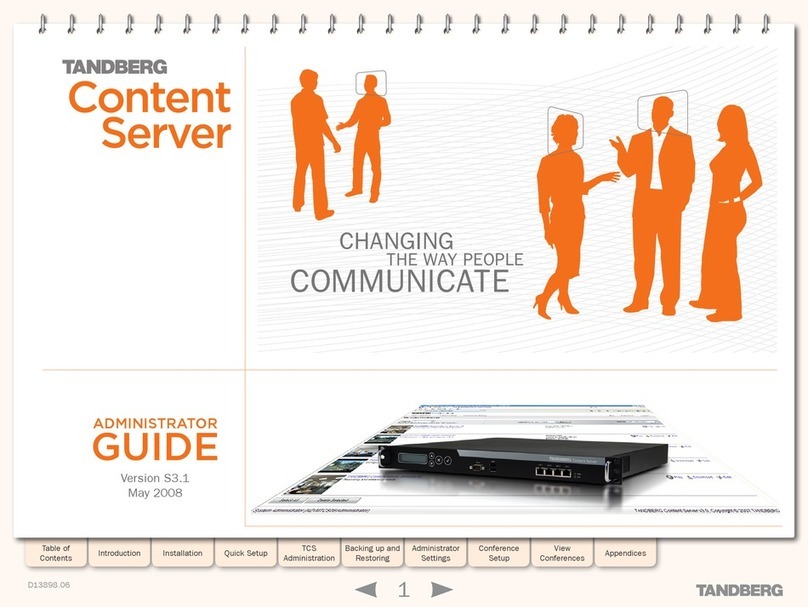
TANDBERG
TANDBERG S3.1 Service manual
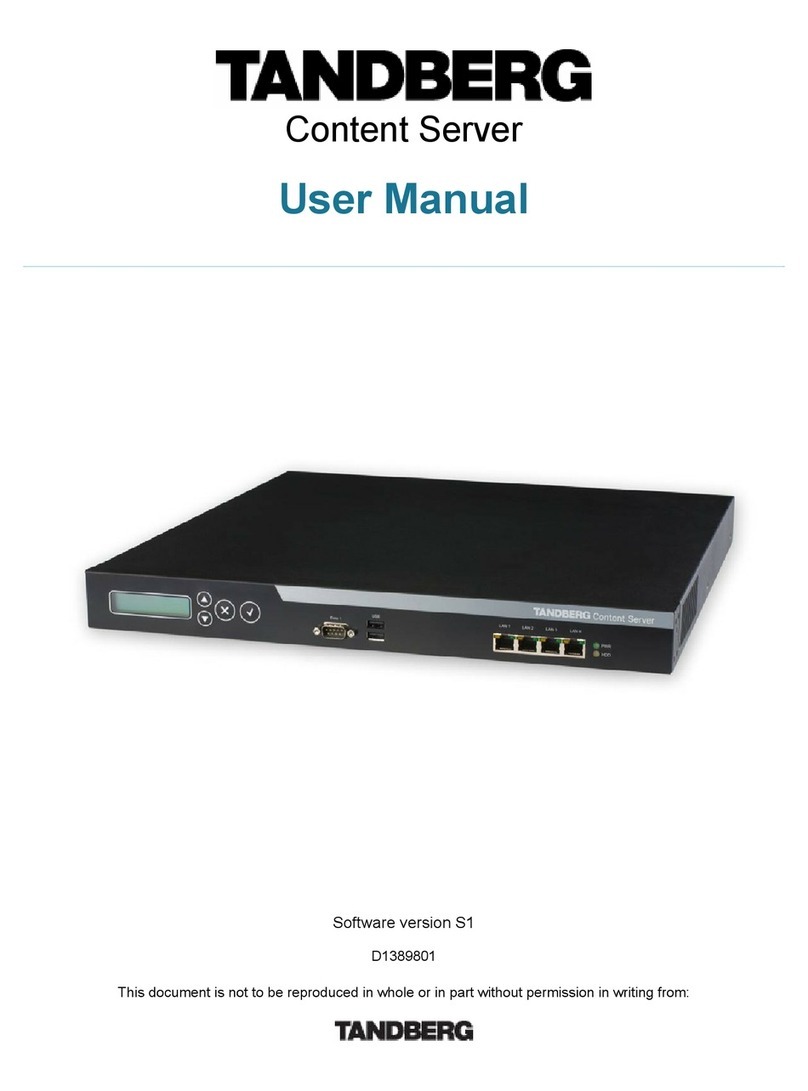
TANDBERG
TANDBERG D1389801 User manual
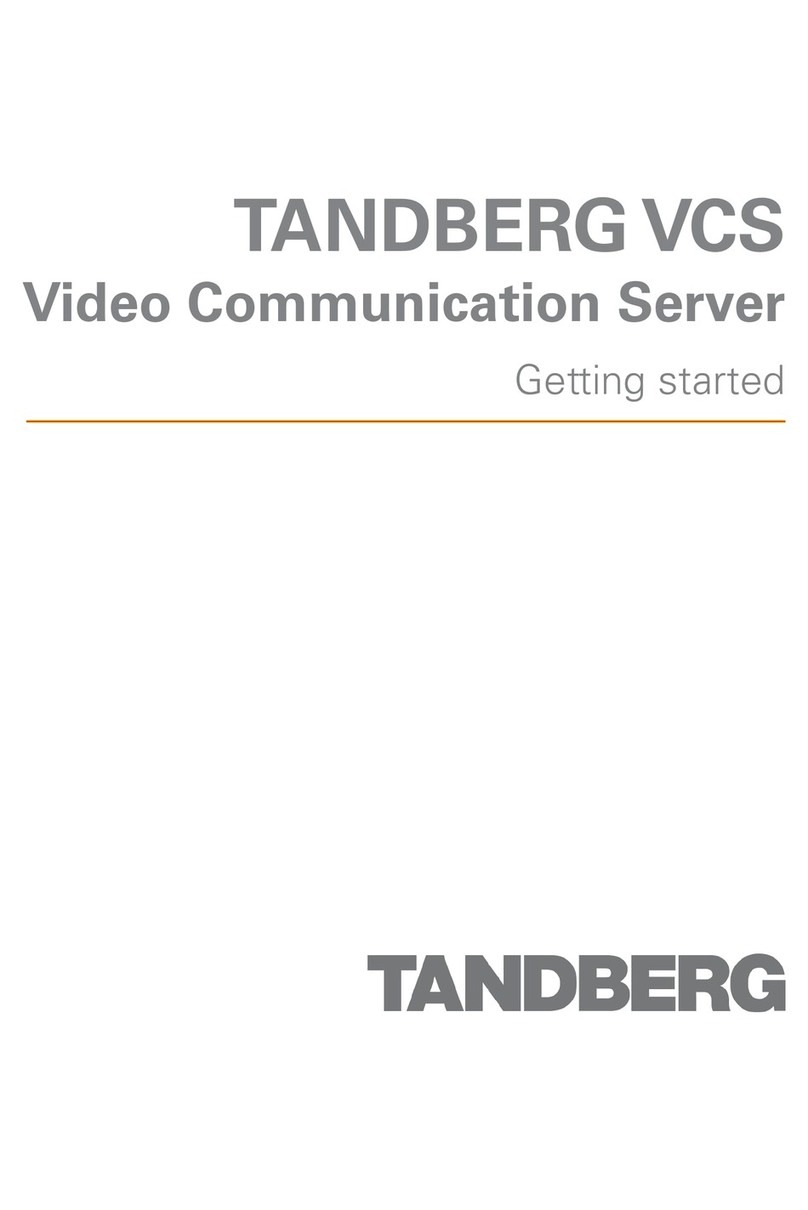
TANDBERG
TANDBERG VCS User manual
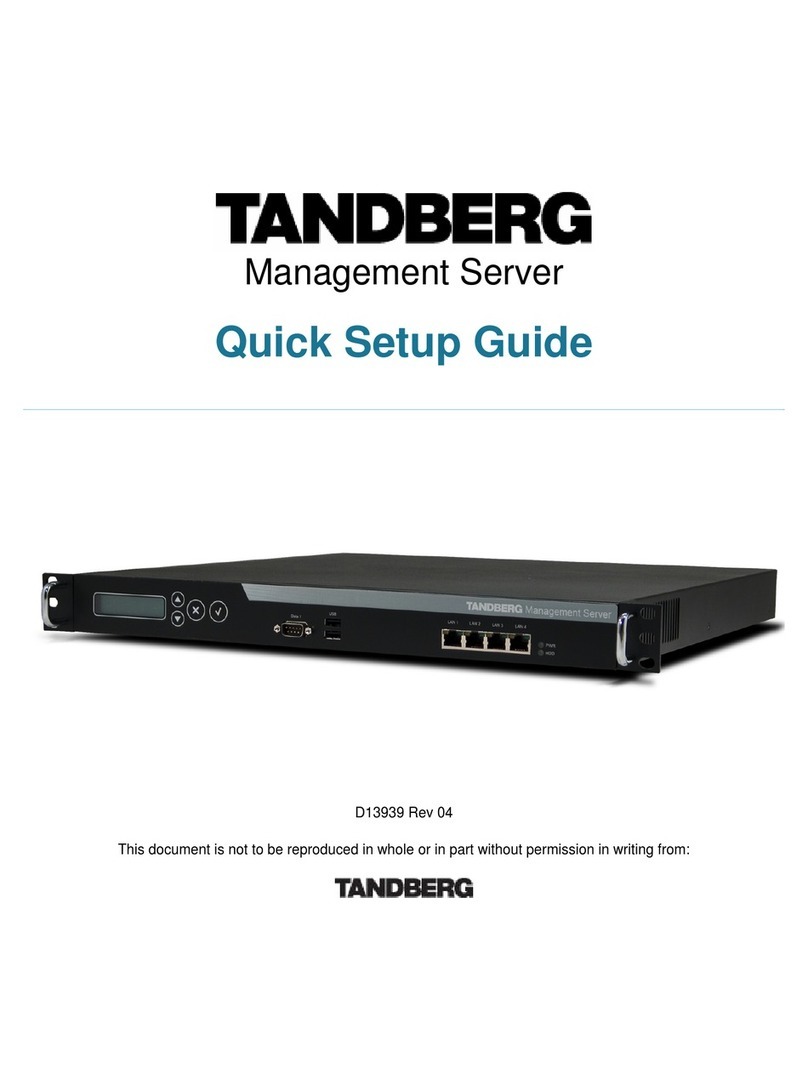
TANDBERG
TANDBERG Management Server D13939 User manual
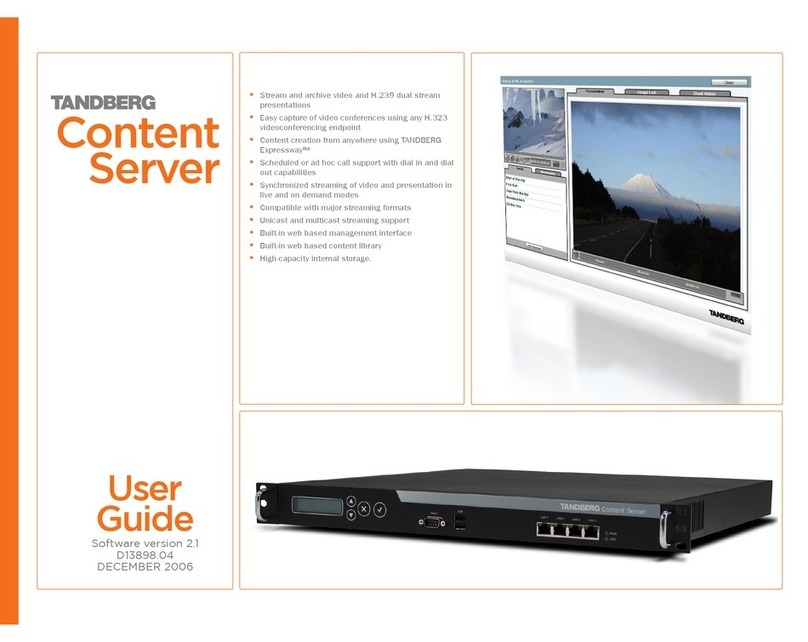
TANDBERG
TANDBERG CONTENT SERVER D13898.04 User manual
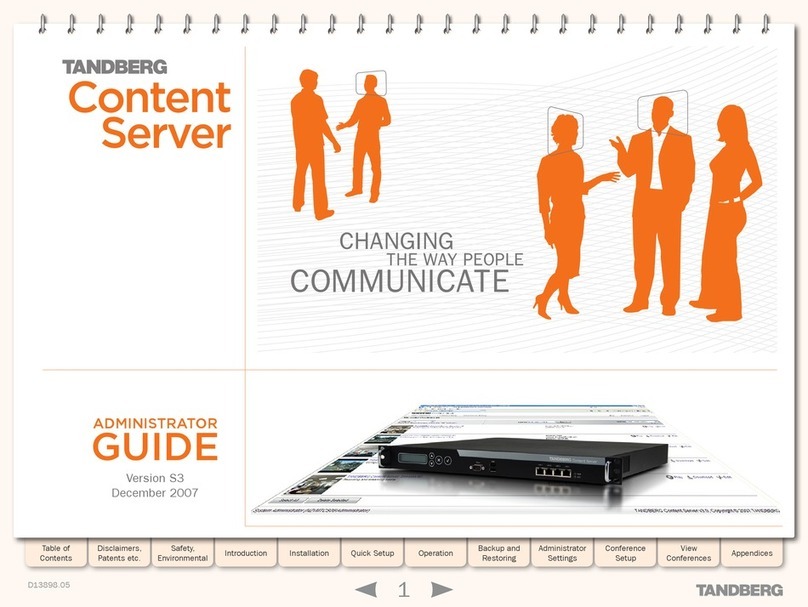
TANDBERG
TANDBERG S3 Service manual

TANDBERG
TANDBERG VCS Service manual

TANDBERG
TANDBERG D14049.04 Service manual
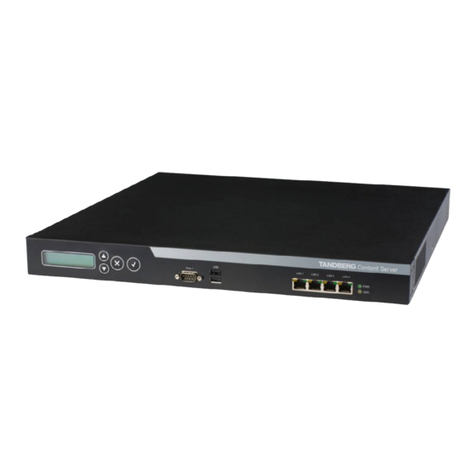
TANDBERG
TANDBERG D1389801 User manual

TANDBERG
TANDBERG VCS Instruction Manual
